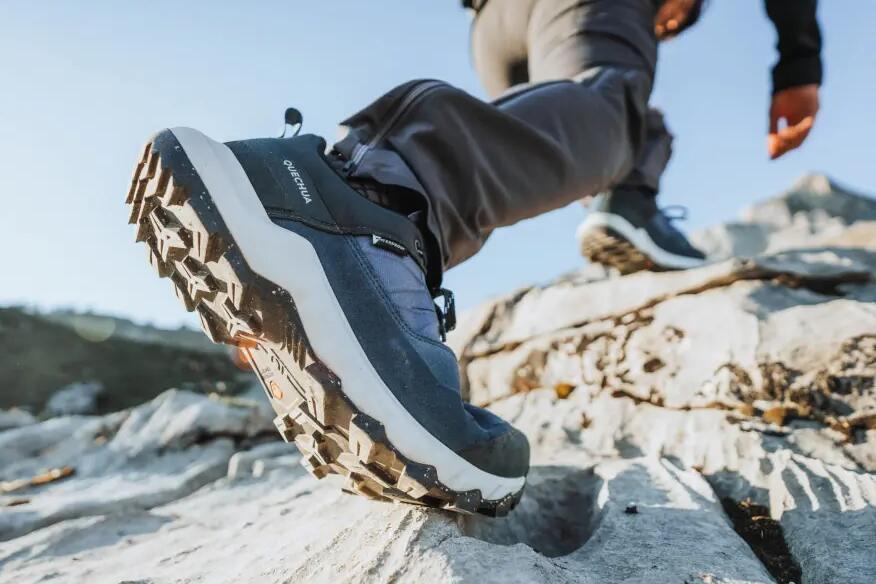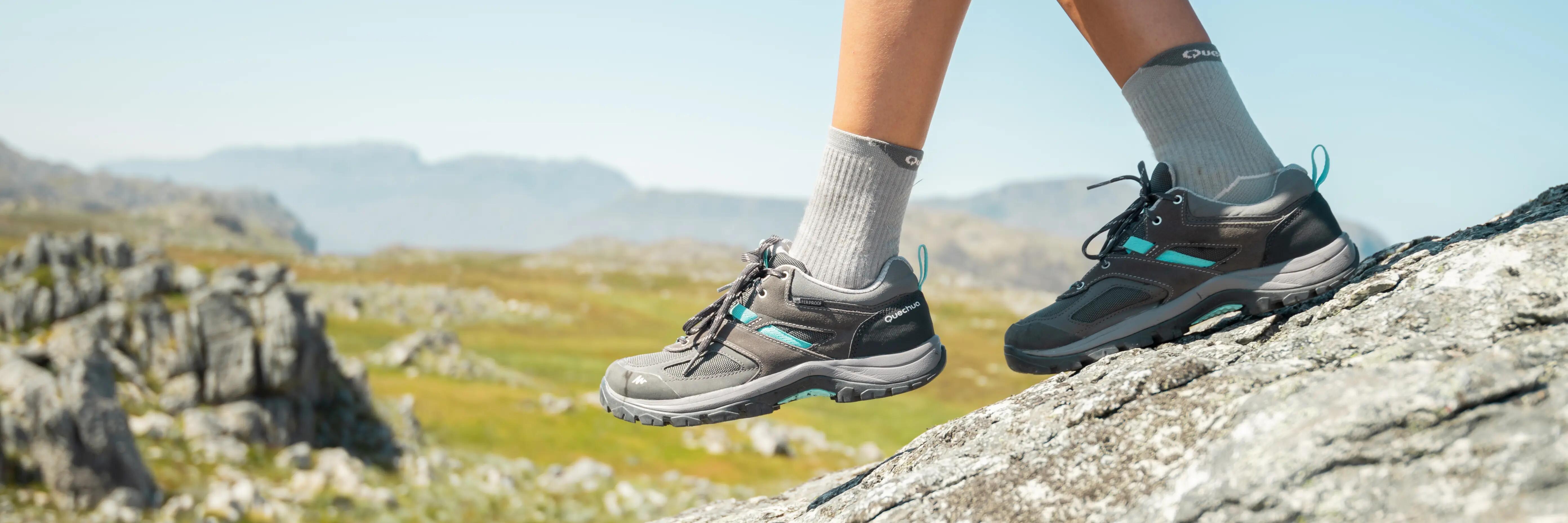
How to choose your right hiking or trekking footwear?
As a hiker or trekker, your shoes
are the most important part of your equipment.
In fact, they are often the first thing you buy to equip yourself! This choice will be essential to enjoy the
landscape without being affected by the nature of the terrain or the elements. But sometimes it's hard to find
them...
So here is the complete guide to good footwear for you!
Your choice of hiking or trekking footwear depends on several criteria:
the practice ground, the length of your hike, the weight of your backpack, your usual footwear and of course,
the weather.
All these factors will help you find the right shoe for you so you can enjoy your hike in comfort and with
peace of mind.
Once you're kitted out, all you need to do is look up and enjoy the scenery!
1. Your practice ground is:
If there is one question you should ask yourself before choosing your footwear, it's “what type of hiking
am I going to do?”.
That is to say, on what type of terrain? For how long? And how heavy is your
backpack?
There is a wide range of hiking shoes available that have been designed according to the
terrain you are going to walk on.
If you're walking on lowlands you won't have the same needs as for
mountain walking.
Each type of terrain has its own particular features.
On lowlands, in the forest or on the coast, with a little elevation:
If you are planning a short day hike on lowlands, in the forest or on the coast, choose hiking boots
from our "nature" range.
These shoes usually have dual density insoles, which means that the first
sole is close to your foot for comfort, while the second sole is close to the ground for cushioning and
insulation from rocks.
Their spikes and outer sole provide excellent grip on certain types of
terrain such as forest trails or on the coast. On the other hand, avoid technical passages or too high a
gradient.
With less rigidity than mountain hiking boots, they provide maximum comfort and cushioning
so that you don't feel the roughness of the trails.
In the mountains, on steep trails:
Are you looking to reach summits on more technical trails with more elevation changes?
If you hike
in the mountains more often and use scree or technical paths, it is best to choose hiking boots designed
specifically for the mountains.
They are more lightweight so your steps aren't as heavy on the
climb.
Their sole and spikes also grip and have good grip so you don't skid on steep trails or in
scree.
These are the two main promises of the CONTACT technology in our Quechua hiking
boots.
Often the front of the shoe is also reinforced with a toe bumper to protect your toes (similar
to safety shoes).
Usually, these hiking boots offer more rigidity, have precise lacing and a foot
support designed to keep you comfortable on all types of terrain.
They also have better ankle
protection thanks to their raised upper - not to be overlooked during the technical passages that can be
encountered in the mountains!
On snowy trails:
Do you want to take on snowy trails and peaks?
Then your choice is completely different! Indeed,
snow means warm and waterproof shoes are needed.
We recommend you choose snow walking shoes that
insulate not only from the cold but also the moisture of the snow.
Snow walking shoes come with a
waterproof and breathable membrane so they don't turn into a sauna for your feet, which would then be
wet by their own perspiration (a sauna is better "after hiking", not during", don’t you agree!).
Their insoles also insulate and the shoes have an anti-ingress system preventing the snow lifted by one
shoe from falling back into the other...
Some of our snow walking shoes come with CONTACT
technology, the result of lengthy tests.
CONTACT insoles are made with a specific
component and stud pattern that is designed to ensure the best possible grip and traction. This makes
them more effective on snow than standard soles.
Combined with a pair of snow socks and choosing a
suitable size to give your toes some room, your shoes will go everywhere with you, without fear of the
cold and snow!
Which insole to add to your hiking shoes for better walking comfort?
The insole is to the shoe what the mattress topper is to the mattress.
People think that they don't
need them and that if they have chosen their shoes well, they can do without them.
This is
absolutely true!
However, your foot may change over time, or the weather may not always be kind to
you.
You can then have a gel insole for maximum cushioning in summer, and opt for a felt insole with
"fleece" for extra warmth, or a leather insole that will fit your foot perfectly over time...
Walking time
If the type of terrain influences your choice of shoes, so should the length of your hike.
Once
again, you will have different needs for a half day outing than for several days. Are you going for a
few days or several weeks?
Are you planning on exploring new trails during a week-long trek?
If the answer is yes then you will need resistant and durable shoes that won't let you down during you
entire stay - even more so if you are going mountain walking for a few days and you can't take several
pairs of shoes.
In this instance, go for trekking shoes. Their durability will get you through
kilometres day after day on all types of terrain. Their high upper also properly supports your ankle
giving greater comfort for the duration.
If instead you plan on hiking for a half-day or full
day, your selection criteria will be different.
In fact, if a trekking boot is more durable, it
can also be heavier that a standard hiking shoe.
For day hiking, go for hiking shoes instead of
trekking.
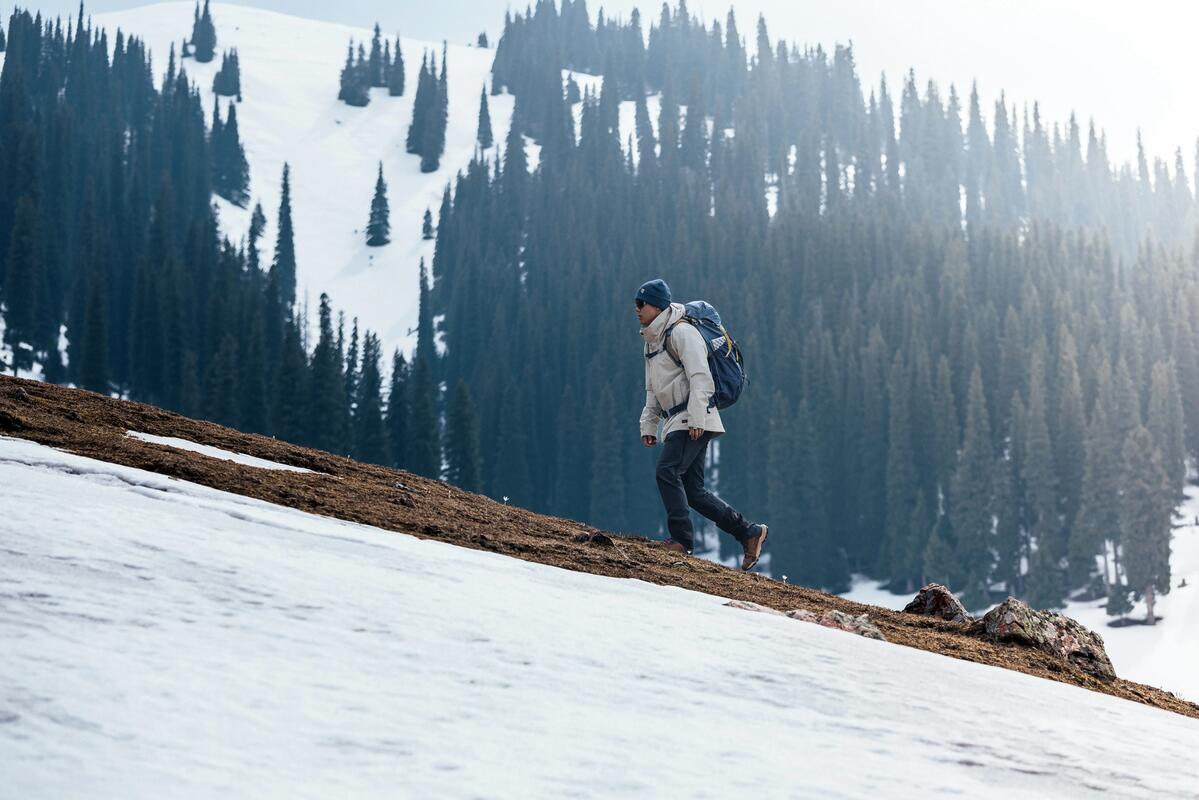
Your backpack weight
Another factor to take into account when choosing your hiking or trekking footwear: your backpack
weight.
Who would think of trying on a pair of shoes in store with 10 kg on their back? Surely not
many people.
However, your backpack weight will strongly influence your choice of footwear.If
you're not carrying a backpack, or it is light because you’re planning a short outing, then you can
choose soft and lightweight shoes, if the terrain allows. On the other hand, if you are carrying a
heavy backpack with your trekking material for a few days then you should choose another type of
footwear. In this instance, you would be wise to choose a high upper boot for greater support, and
more rigid for greater stability.

Support and fit
Is it better to have high or low hiking shoes?
There are two other factors to take into account: support and fit.
A high upper will be useful to
support your ankle if you walk on rugged or steep trails.
This also stops stones or dust for example
from getting inside the boot.
Moreover, if you have followed correctly, the weight of the bag can
influence the choice of the height of your shoe's upper: the heavier your backpack, the more support you
will need for your ankles with a high upper.
If you are looking for lightness and freedom of movement
for your ankle, choose a low upper.
What size hiking boots?
We often hear that you should go up a size for hiking boots... but not necessarily! In fact, it’s
different for everyone. Indeed, our feet do not all "swell" the same with effort, some people have a
difference of half a size between their right and left foot, etc.
I'm sorry I can't give you a
universal solution to this question...
The best option is to try your hiking boots at the end of the
day, with hiking socks.
What differences are there between men's and women's hiking boots?
Some brands of hiking boots take into account average differences between men's and women's feet.
This does not mean that these averages are absolute morphological realities, nor does it mean that
they necessarily fit you individually.
For example, the width of the foot is sometimes wider in the
men's range.
In addition, sizes often start at 6 in the men's range. Again, try on what you like and
trust your feelings: your foot will tell you if it feels comfortable or not.
So, if you prefer a
man's design when you are a woman (or vice versa), and you find your size and it feels good then go for
it!
Weather
Waterproof hiking boots in wet weather:
For the final steer in your choice, here is one last criteria to consider: the weather.
On dry
ground or with a little morning dew, waterproof shoes aren't required.
A water-repellent shoe will
do the job.
The drops of water slide off the fabric and your feet stay reassuringly dry.
On
soaked ground, during a rainy hike or feet in 40 centimetres of fresh snow, don't even ask yourself
the question: choose a waterproof shoe that will insulate you from moisture.
Laboratory tests help
you evaluate a shoe's waterproof level. During these tests, the shoes are half immersed in water and 3
levels of waterproofing are tested: 2,000 flexes (approx. 4 km walk), 4,000 flexes (approx. 8 km walk)
and 8,000 flexes (approx. 16 km walk).
These different waterproof levels are stated in the features
of the footwear.
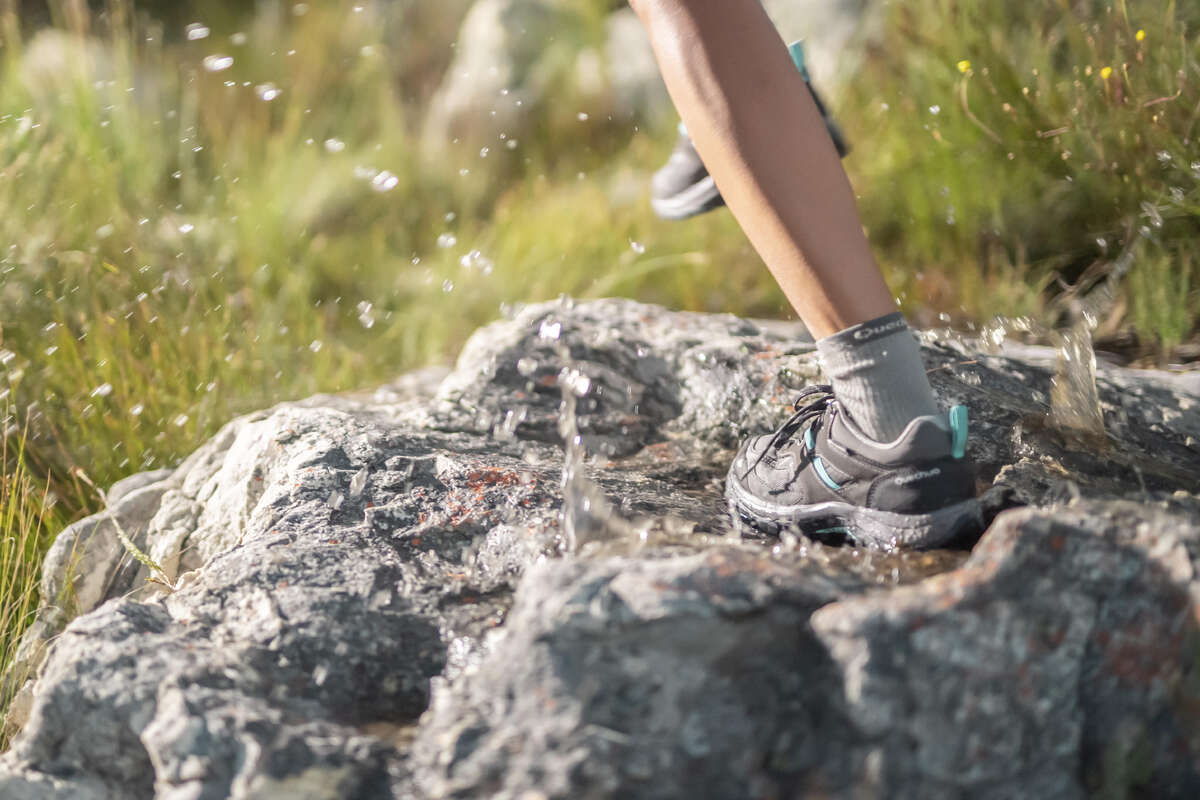
Lightweight and breathable summer shoes in warm and dry weather
Do you generally hike in high summer when it's very hot? Breathable hiking shoes are the answer! These
models have greater breathability thanks to the mesh used and they stop you perspiring when hiking. There
is nothing more uncomfortable than hiking with a damp foot that sometimes slides in the shoe!
If you
want complete foot ventilation, go for sandals. Their sole and toe bumper, at the front of the shoe,
protect the foot and give the same grip as a boot.
The final small word: to avoid blisters, stay warm (or cool) and protect yourself from insects in the tall grass, don't neglect your choice of hiking socks!
HIKING SOCKS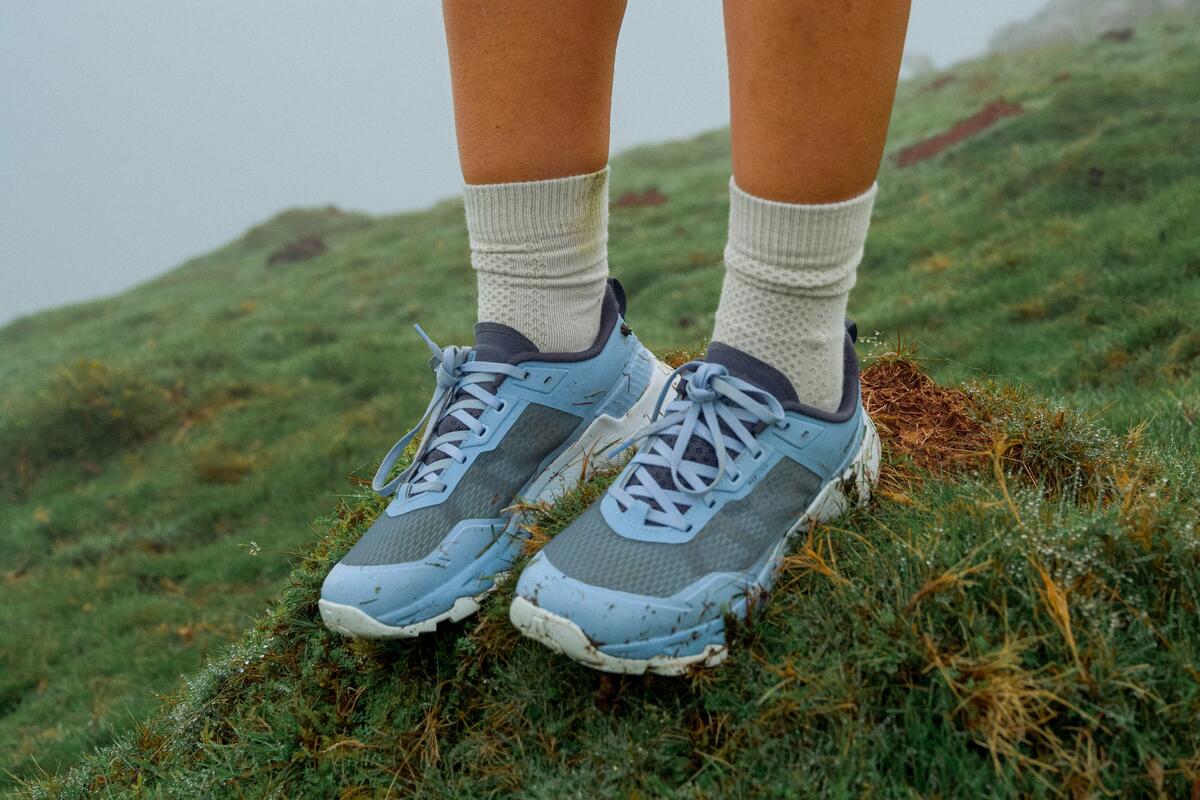
Now you're fully kitted out, the trails await!
- Maguy Quechua hiking enthusiast

